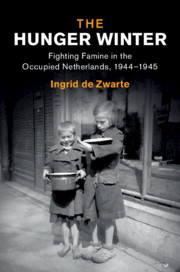Book contents
- The Hunger Winter
- Studies in the Social and Cultural History of Modern Warfare
- The Hunger Winter
- Copyright page
- Dedication
- Contents
- Illustrations
- Figures
- Maps
- Tables
- Acknowledgements
- Abbreviations
- Maps
- Introduction
- 1 Historical Contexts
- 2 Causes of the Famine
- 3 Effects on Mortality, Fertility, and Health in Later Life
- 4 Central Government and Food Administration
- 5 The Politics and Practices of Allied Relief
- 6 Coping at Household and Individual Levels
- 7 Community Strategies
- 8 The Evacuation of Children
- Conclusion
- Appendix: Timeline of Important Events
- Bibliography
- Index
7 - Community Strategies
Published online by Cambridge University Press: 04 July 2020
- The Hunger Winter
- Studies in the Social and Cultural History of Modern Warfare
- The Hunger Winter
- Copyright page
- Dedication
- Contents
- Illustrations
- Figures
- Maps
- Tables
- Acknowledgements
- Abbreviations
- Maps
- Introduction
- 1 Historical Contexts
- 2 Causes of the Famine
- 3 Effects on Mortality, Fertility, and Health in Later Life
- 4 Central Government and Food Administration
- 5 The Politics and Practices of Allied Relief
- 6 Coping at Household and Individual Levels
- 7 Community Strategies
- 8 The Evacuation of Children
- Conclusion
- Appendix: Timeline of Important Events
- Bibliography
- Index
Summary
Chapter 7 provides a detailed account of social self-organisation at the local level, the constitution of the main NGO during the famine, local child-feeding initiatives, as well as women’s food protests. This chapter demonstrates that the final months of war presented a period of declining legitimacy of state authority in the food system, which led to the rise of new types of organisations: local self-organised relief and self-help entities. Emerging from existing networks, these civil society organisations occupied a central position between the household and state levels and effectively took over care and relief responsibilities. These community efforts can be qualified as a great success and are crucial to explaining why certain groups – children in particular – fared better during the famine than others.
- Type
- Chapter
- Information
- The Hunger WinterFighting Famine in the Occupied Netherlands, 1944–1945, pp. 203 - 230Publisher: Cambridge University PressPrint publication year: 2020

